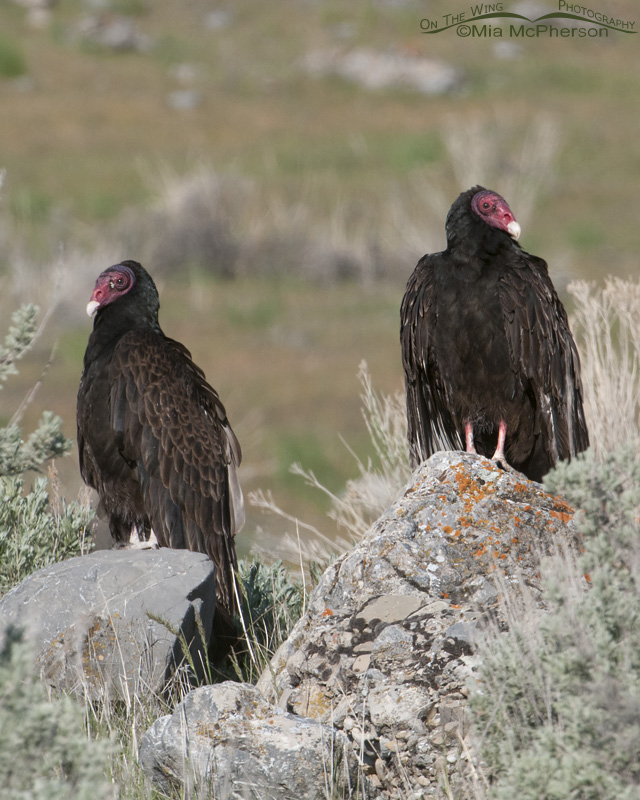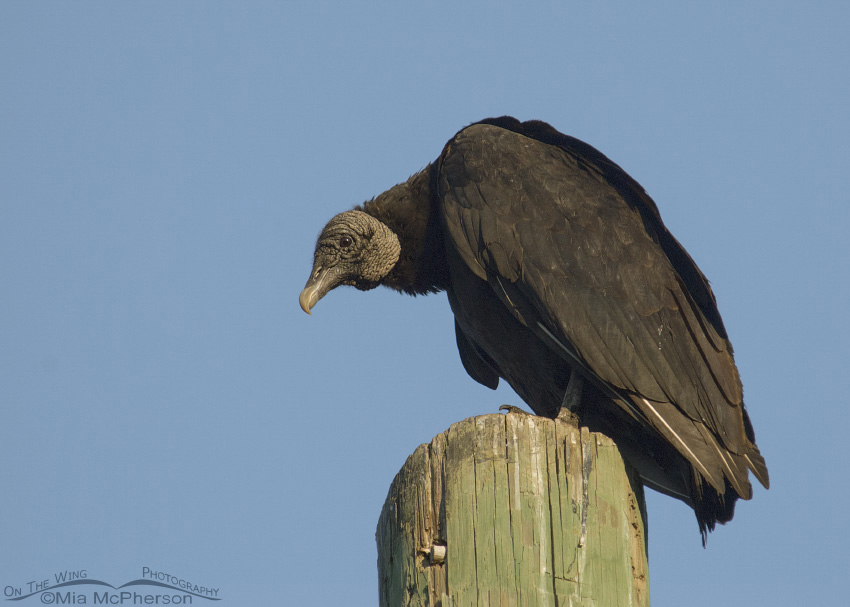 Pair of Turkey Vultures in Box Elder County
Pair of Turkey Vultures in Box Elder County
Today is International Vulture Awareness Day so I thought I would share images of Turkey and Black Vultures. Sure, vultures aren’t are handsome as Bald Eagles but they do serve an ecological function of cleaning up carrion so in essence they are nature’s recyclers.
Here in the U.S. we have three species of vultures, the California Condor, Turkey Vulture and Black Vulture. The California Condor is making a comeback but we mustn’t forget that they sat on the brink of extinction. There are vultures in other countries that are also endangered and nearing extinction so raising awareness globally might help them.
 Mature Black Vulture on a pole
Mature Black Vulture on a pole
In 2003, the Boise-based Peregrine Fund found that a drug called diclofenac, an anti-inflammatory drug used on livestock in East Asia, was responsible for the sudden death of huge numbers of Gyps vultures.
Other vultures in the world are killed simply because they are seen as a threat to livestock.
Our Turkey and Black Vultures here in the U.S. aren’t endangered but we need to be good neighbors and raise awareness for those that are.
Life is good. Carrion.
Mia
Click here to view more of my Turkey Vulture photos plus facts and information about this species. Click here to view more of my Black Vulture photos plus facts and information about this species.


Just wanted to share this bit of optimistic history (from The Peregrine Fund site).
“Our effort to save the Peregrine Falcon from extinction typifies our approach to problem solving. When it became clear in the 1960s that Peregrine Falcons, Bald Eagles and other birds of prey were in trouble due to the effects of DDT, we set our sights on stopping the slide to extinction. Led by our founder Tom Cade, then a professor of Ornithology at Cornell University, The Peregrine Fund pioneered methods of breeding Peregrine Falcons in captivity and successfully releasing them to the wild. Almost 30 years later, we proudly hosted an international celebration when the Peregrine Falcon was removed from the U.S. Endangered Species List in 1999.”
Love to see the Turkey Vultures soaring, usually several together, in their rocking motion. Thanks for the info about the Peregrine Fund. It only takes a trace to cause death in the vultures, and India suffered the results.
“The Peregrine Fund discovered in 2003 that the veterinary drug diclofenac was responsible for a catastrophic collapse of vulture populations in South Asia in less than a decade. The drug was banned for veterinary use in 2006 by India, Pakistan and Nepal, and Bangladesh took similar action in 2010.”
Great post for a much under appreciated family, Mia. I never tire of watching them or looking at your images, for that matter.
I also enjoyed reading the WP article. A subject I’m keenly interested in. Great work!
Thank you (and Patty) for that link.
Clean-up is such an important role. Such a beneficial role. Something we could consider before dissing the vulture. And rather a lot of other ‘lesser’ species…
Mia..please provide a link, guess that’s the right word, to your Washington Post article so others can pick up on it…too important not to share…thanks, Patty
Hi Patty, here is the link: Ten animals that will disappear with Western sagebrush
I remember vividly back in the ‘6os when they were starting to try to bring back the California Condor, which, at the time, I thought was the ugliest excuse for a bird on the planet. Fast forward to 2010 when we went to the San Diego Wild Animal Park and saw them up close. I was finally able to see the great beauty in the California Condor. I have been introduced to some other species of Vultures from around the world, and have discovered that there are many beautiful ones. They are more than just natures recyclers.
I can clearly remember how excited I was to see my first turkey vulture, after many, many years of never seeing any. I was on my way to work, passing a large reservoir and there it was, right on the road in front of me. Now we see plenty of them, almost always soaring, riding the thermals. At first, we only had Turkey Vultures, but now we see the more aggressive blacks, too.
Beautiful pictures, Mia. A favorite of mine going back to my young years in West Texas.
Maybe I’m a bit strange, but vultures have always been my favorite birds. Sure, as you say, they don’t have the handsomest faces, but they’re extremely graceful, laid back fliers and I love watching them! Thanks for sharing the pics!